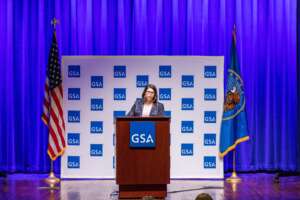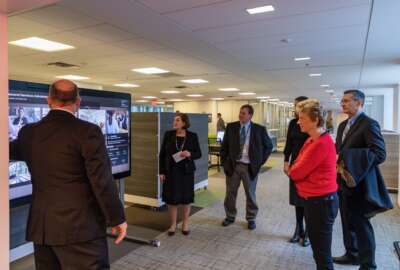

Nina Albert, the commissioner of the Public Building Service at GSA, said with approximately 50% of GSA’s lease portfolio expiring in the next five years, age...
The future look and feel of your office space isn’t just going to be filled with movable furniture or whiz-bang technology. It likely will include federal employees from other agencies.
The latest trend the General Services Administration is hearing from agencies is the desire to share buildings, conference space and training rooms as a part of reducing costs and improving the employee experience.
Nina Albert, the commissioner of the Public Building Service at GSA, said federal office space will continue to evolve over the next few years as more agencies get a better handle on their short and long-term needs.

“Agencies are willing and interested in having the conversation about when is the appropriate time to share space? What types of spaces are you willing to share?” Albert said in an interview with Federal News Network after speaking at the Shared Services Summit sponsored by ACT-IAC and the Shared Services Leadership Coalition on Tuesday. “We’re engaging with agencies on those topics. There’s no clear decisions yet. But I just think about conference space that’s going to be of greater need in the future as people pull their teams together in off sites, or what we’re now calling on sites. Those types of conference spaces are in high demand, so are those the right types of spaces to be sharing? There’s other kinds of spaces like training labs that agencies could be sharing too, and as a result, they could garner some additional space efficiency. I think everyone’s looking for that now.”
Albert said the sharing of space could mean having multiple agencies in the same building, but on different floors. Or it could mean having a small number of employees from different agencies working on the same floor, but in different office space.
GSA believes it has a huge opportunity to help agencies and employees save money, whether around consolidating office space or reducing the commute time of employees when they do go into the office. GSA owns or leases office space in 2,200 communities around the country.
At the same time, approximately 50% of GSA’s lease portfolio is expiring in the next five years, putting some additional urgency on top of these plans.
Agencies submitted their office space plans to the Office of Management and Budget in December detailing their needs through 2028. OMB, however, has not publicly released those agency plans.
Albert said GSA is meeting with agencies at least two years before their leases are set to expire to understand their needs and begin developing plans for the office space.
“We really work with them to determine what their longer term needs are, whether we should be reupping or taking on a new lease, or what we’re trying to promote as reuse or use of our existing federal space to consolidate those leases, and you’re seeing that activity, it’s really what I call blocking and tackling,” she said. “The model that’s becoming interesting to agencies is what I’ll call federal co-working, which is, in fact, shared space, where we would have all the amenities of flexible space in one suite. Maybe multiple agencies who only have a small team, for example, in city X, and they still want to have access to the safety, security and access to an office, but they don’t need an entire suite to themselves. They’re willing to share with another agency that might also have a small team need.”
Albert said a lot of these discussions about trends and federalwide needs has driven conversations in the Federal Real Property Council as well as through GSA’s own Workplace 2030 initiative. The council is focused more broadly on federal real property that includes land, science labs and warehouse space. The Workplace 2030 initiative, launched during the pandemic, is more focused on the future of office space.
Part of the Workplace 2030 initiative is GSA’s Workplace Innovation Lab, launched in January, to let federal agencies and others test out new and different approaches to configuring office space.
“We have a backlog, I think of about 120 tours, with different agencies wanting to come and see the lab. It’s not limited to the federal government. This is the first workplace innovation lab of its kind in the country so we’re seeing private sector partners wanting to come and take a look at it and see what we’re doing. We’re also hosting other governments to come and check it out,” Albert said. “Why are they so excited about it? I think it’s because people really want to understand how flexibility is manifesting in space. Usually, when you’re building out real estate, there’s something fixed about it. The furniture manufacturers and the technology, providers are all really trying to figure out how do you build in as much flexibility as possible because we know that the next several years are going to require that?”
Albert said GSA will continue to showcase these new furniture and technology configurations as well as closely watch its six-month pilot around federal co-working space at the innovation lab and at two other sites around the country.
She said the six-month pilot is “what we’re really testing for to see what the demand, the interest, and the need would be for that kind of space because I think that that could be a truly innovative approach for federal real estate in the future.”
A key piece to the future of federal office space is a legislative proposal GSA submitted as part of its fiscal 2024 budget request.
Albert said GSA is asking Congress to give GSA full access to the Federal Buildings Fund and to increase GSA’s prospectus threshold from $3.5 million to $10 million.
“That would allow us to save two years’ worth of process time, as well as $50 million a year in cost, just based on process alone,” Albert said. “A lot of the conversations that we have are really about how GSA is getting access to the Federal Buildings Fund, how that would support agency moves, consolidations and facility modernizations, which is really important because we have a lot of deferred maintenance problems that we’re dealing with. All of these consolidation opportunities are really reliant on our getting full access to the Federal Buildings Funds.”
Copyright © 2024 Federal News Network. All rights reserved. This website is not intended for users located within the European Economic Area.
Jason Miller is executive editor of Federal News Network and directs news coverage on the people, policy and programs of the federal government.
Follow @jmillerWFED


